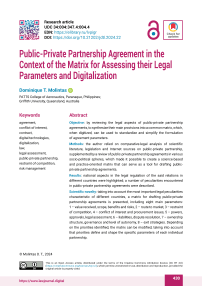Public-Private Partnership Agreement in the Context of the Matrix for Assessing their Legal Parameters and Digitalization
Автор: Molintas D. T.
Журнал: Journal of Digital Technologies and Law @lawjournal-digital
Статья в выпуске: 2 (2), 2024 года.
Бесплатный доступ
Objective: by reviewing the legal aspects of public-private partnership agreements, to synthesize their main provisions into a common matrix, which, when digitized, can be used to standardize and simplify the formulation of agreement parameters. Methods: the author relied on comparative-legal analysis of scientific literature, legislation and Internet sources on public-private partnership, supplemented by a review of public-private partnership agreements in various socio-political spheres, which made it possible to create a science-based and practice-oriented matrix that can serve as a tool for drafting public-private partnership agreements. Results: national aspects in the legal regulation of the said relations in different countries were highlighted; a number of peculiarities encountered in public-private partnership agreements were described. Scientific novelty: taking into account the most important legal peculiarities characteristic of different countries, a matrix for drafting public-private partnership agreements is presented, including eight main parameters: 1 – value received, scope, benefits and risks, 2 – route to market, 3 – restraint of competition, 4 – conflict of interest and procurement issues, 5 – powers, approvals, legal assessment, 6 – liabilities, dispute resolution, 7 – ownership structure, governance and level of autonomy, 8 – exit strategies. Depending on the priorities identified, the matrix can be modified, taking into account that priorities define and shape the specific parameters of each individual partnership. Practical significance: the matrix obtained can become a planning tool used to analyze and understand the relationships between the eight legal parameters necessary for the formation of relations in the sphere of public-private partnership. It may serve as a legal reference point for the formulation of public-private partnership agreements around the world, and will contribute not only to the revitalization of public-private partnerships, but also to a proper understanding of obligations, responsibilities and limitations. The recommendations provided in the study show direction for the evaluation of public-private partnerships, allowing clear conclusions to be drawn about the partnership. Digital accessibility provided, the proposed matrix will be of interest to many organizations that use public-private partnerships in their professional activities.
Agreement, conflict of interest, contract, digital technologies, digitalization, law, legal assessment, public-private partnership, restraint of competition, risk management
Короткий адрес: https://sciup.org/14130005
IDR: 14130005 | УДК: 34:004:347.4:004.4 | DOI: 10.21202/jdtl.2024.22


